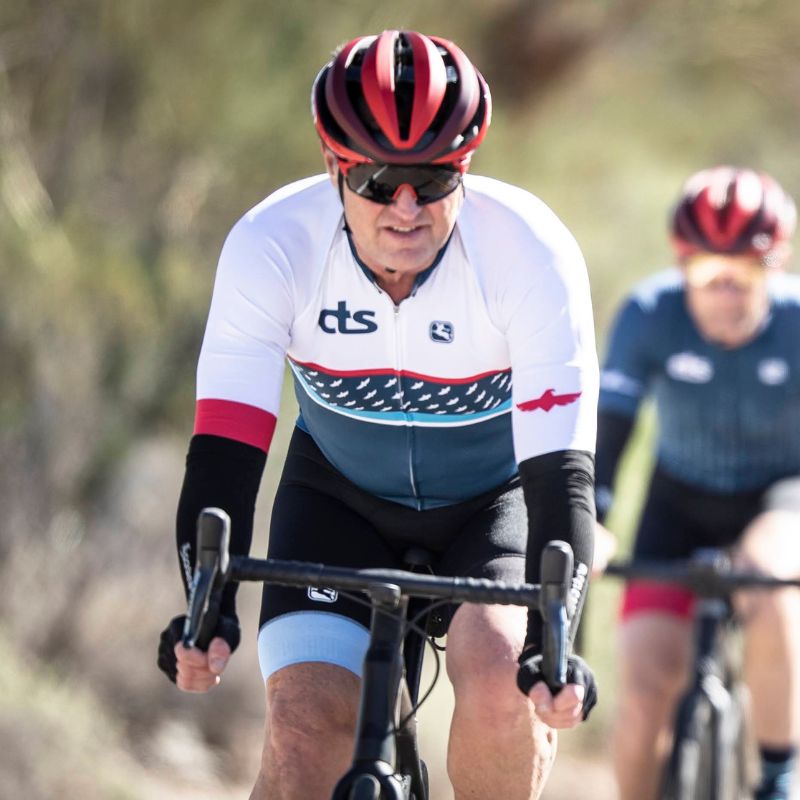
How INSCYD Testing Can Unlock Your Athletic Potential
By Chris Carmichael,
Founder and Head Coach of CTS
Game changing technological advances that truly improve athletic performance are relatively rare. Sure, there are iterative advances in power meters and new features added to apps, but substantive changes don’t happen very often. That’s why athletes should be excited about INSCYD, a training software and athlete testing protocol that delivers actionable insights that allow for greater training personalization than ever before.
How INSCYD Can Make You Faster
I’ll explain each of these in more detail below, but the short version is:
- Customize interval durations based on how you produce power, not just the output.
- Customize recovery intensities to maximize readiness for your next effort.
- Customize high-intensity power zones from relevant high-intensity test efforts, rather than from longer time trial.
- Customize fueling strategy based on your personal energy metabolism.
What is INSCYD
INSCYD’s Sebastian Weber and his team launched Power Performance Decoder software after developing a non-invasive testing protocol on the bike to detect the maximum glycolytic performance (VLamax, or maximum rate of lactate production). This allowed them to calculate anaerobic threshold (or lactate threshold) by looking at lactate production and clearance. When their calculations were put up against lab-based lactate threshold tests, they matched, again and again.
For the first time, coaches and athletes have an accurate, repeatable, non-invasive field testing protocol that delivers insights that are as useful and actionable–and in some cases, more useful–than lab testing. The test itself features multiple efforts at varying intensities, not just one 20-minute time trial or a ramp test. The protocol yields good results from athletes unaccustomed to testing because the efforts are realistic to efforts in real life.
Testing outside a physiology lab, or field testing, is typically limited to providing power output, heart rate, and maybe blood lactate values. Those are valuable, but INSCYD provides insights on how an athlete is producing power, not just the outcome. It’s one thing to know how much horsepower a car can produce; INSCYD gives us a good look under the hood to see how the engine is working. That’s why CTS has partnered with INSCYD.
Feel Stronger in 6 Weeks — No Matter Your Age
Climbs feel steeper? Recovery slower?
You’re not done getting faster — you just need a smarter plan.
The 6-Week Masters Power Build Coaching Program is designed for cyclists 50+ who want to boost power, recover faster, and ride stronger — all with expert 1:1 coaching.
- Personalized 6-Week Training Plan
- 1:1 Coaching + TrainingPeaks Premium
- Mobility & Strength Bonus Guides
💪 Guarantee: Stronger or free.
Start your 6-week journey for $149How INSCYD Benefits Athletes
Coaches and sports scientists love to discover new metrics and ways to slice and dice data. Athletes want to know how these new things are going to make them faster. Great, it’s a new test. What’s in it for you?
Personalize recovery duration and intensity
“How easy should I go between intervals?” is a question we get all the time. The standard answer is to spin easy until it’s time to start the next effort, but in reality everyone clears lactate at a different rate, and for some athletes, riding at a moderate intensity (140W instead of spinning easy at 70W) can help reintegrate lactate into normal aerobic metabolism faster.
Lactate clearance rate is important because interval training and hard efforts increase the amount of energy you derive from anaerobic glycolysis, which produces energy from carbohydrate faster than you can aerobically produce energy from fat. One of the products of glycolysis is lactate, which can be thought of as partially burned glucose. The faster you demand energy via anaerobic glycolysis, the more lactate you produce. At the same time, lactate is being broken down through aerobic metabolism alongside fat. When the rate of lactate production is greater than the rate at which your muscles can break it down aerobically, lactate starts to accumulate in muscles and blood.
Lactate clearance, or how fast you’re burning lactate for energy and reducing lactate levels in muscle and blood, is partly controlled by how much energy you’re demanding during recovery periods. Easy spinning might be too easy, and you might achieve greater and faster reductions in lactate levels by recovering at a moderate power output instead. Better recovery means you can produce a higher quality effort for the next interval, and maybe have the strength for more intervals within a workout.
The ability to individualize intervals and both the duration and intensity of recovery periods is a big deal. In 1990s with Project ‘96 we were individually testing the US Team Pursuit athletes and we could see that recovery times between intervals needed to be individualized, as well as intensity of recovery periods. From then to now, we’ve had no practical way to do this remotely, at scale, and with accuracy. You could do it, but it required a mountain of data over a long period of time, and even then, it was interpretation. Now we can do it and back it up with data.
Fine tune the components of power output
For a long time, we’ve been able to use lab and field testing to get a pretty accurate value for an athlete’s anaerobic threshold (whether you call it FTP or lactate threshold or anaerobic threshold, they’re looking for essentially the same metric). And we know how to create power ranges and interval workouts to increase an athlete’s power at anaerobic threshold for a given duration. Outside of the lab, what has been more difficult to discern is how an athlete is producing that power. INSCYD gives us the ability to look under the hood, or under your skin, to get a better picture of the components of your power output, so we can target individual components for improvement.
► Free Cycling Training Assessment Quiz
Take our free 2-minute quiz to discover how effective your training is and get recommendations for how you can improve.
For instance, let’s say you have an anaerobic threshold power of 300W. With the insights from INSCYD we can prescribe training to lower VLAmax or increase Fat Max, even if anaerobic threshold power stays constant in the short term. By adapting how you produce power, we can create the infrastructure or environment conducive to increasing power and power duration at anaerobic threshold.
INSCYD also provides insights into the amount of oxygen you’re consuming at anaerobic threshold and VO2 max. Let’s say you’re consuming 3 L of oxygen per minute (absolute, not relative to weight) at 300W, and then after a period of training your next test indicates you’re consuming 2.8 L/min of oxygen to produce that same 300W. And with the other information from the testing we can get a good picture of what components of your performance led to the reduction in the oxygen cost of producing power.
Customize fueling strategy based on your personal energy metabolism.
Generally speaking, we know that you are always burning a mixture of fat and carbohydrate for energy, even as you sit and read this. How quickly you demand energy determines the composition of the mixture. At low intensities, the vast majority of your energy comes from essentially limitless supply of fat, which spares your limited supply of carbohydrate energy, so you have it to fuel harder efforts later into your training session or competition. At moderate intensities most people are burning about a 50/50 mix of fat and carbohydrate. As intensity increases from here, the proportion of energy coming from carbohydrate ramps up quickly and the proportion from fat drops. But when we know how your individual energy composition changes, we can increase the precision of training and feeding strategies.
Some athletes burn less fat than expected, even at low intensities. Some athletes don’t spare carbohydrate stores as expected. With INSCYD we can identify athletes who are outliers in terms of fat oxidation and carbohydrate sparing, and subsequently adjust training to optimize their fuel utilization. For instance, we may do longer aerobic endurance (EnduranceMiles, Zone 2) rides with delayed feeding of exogenous carbohydrate, along with other low carbohydrate availability strategies.
For harder efforts, INSCYD provides insights on the caloric expenditure per hour, and the breakdown of energy coming from carbohydrate and fat at a given power output. So, if you are averaging 200W and burning 700 Calories/hour, we can figure out the substrate composition that produced the energy to maintain that intensity. From there, we can personalize feeding by narrowing the calorie intake ranges at specific intensities.
The general recommendations are 30-60 grams of carbohydrate per hour, with a potential increase to 90+ grams/hr by consuming combinations of sugars and training the gut. But overeating is a major contributing factor for gastric distress, so we really only want athletes to eat what they need. If anything, underfeeding is safer because athletes can quickly compensate by eating a little more, whereas after overeating there’s nothing to do but slow down and wait. With INSCYD we can increase the personalization of nutrition strategies by intensity level, optimizing performance and lowering the risk of gastric distress.
INSCYD Testing from CTS
Select CTS Coaches will soon begin providing cycling-based INSCYD testing services for all athletes, including but not limited to CTS-coached athletes. Learn more about INSCYD testing from CTS. If you are not already on our email list, get signed up here to receive CTS Newsletters and notifications about the availability of INSCYD testing.
► FREE Mini-Course: Learn How to Maximize Your Limited Training Time
Learn step-by-step how to overcome limited training time and get faster. Walk away with a personalized plan to increase your performance.
"*" indicates required fields


Comments 4
What about endurance runners? I recently signed on with CTS and am beginning to realize that CTS’ primary focus is on cyclists, and in articles like this, essentially ignoring their endurance runner clients. It might be worth CTS’ while to at least give some thought to runners in articles like this.
Author
Welcome to CTS. We publish three blogs per week (Tues/Thurs/Sat) and Tuesdays are dedicated to running and ultrarunning exclusively. If you would like to only receive that content, we can adjust the list segmentation accordingly. Including recent hires, we’ll have 16 professional ultrarunning coaches on staff. Chris’s content (Saturdays) typically focuses on cyclists or more generally to topics that apply to all endurance athletes. In particular, this article focuses on cycling because the INSCYD software and testing protocol is currently available for cyclists. They are developing a product that applies to running, which they should be releasing in 2021. When it is available, we will certainly produce content that focuses on the specific benefits it delivers for runners.
– Jim Rutberg, CTS
Totally agree! I do triathlons and so would find it helpful for running and cycling.
John, I could see how you read this as only being for cyclists, but actually, INSCYD testing is also available for runners. So all of those metrics and fueling descriptives can be had for cyclists and runners.